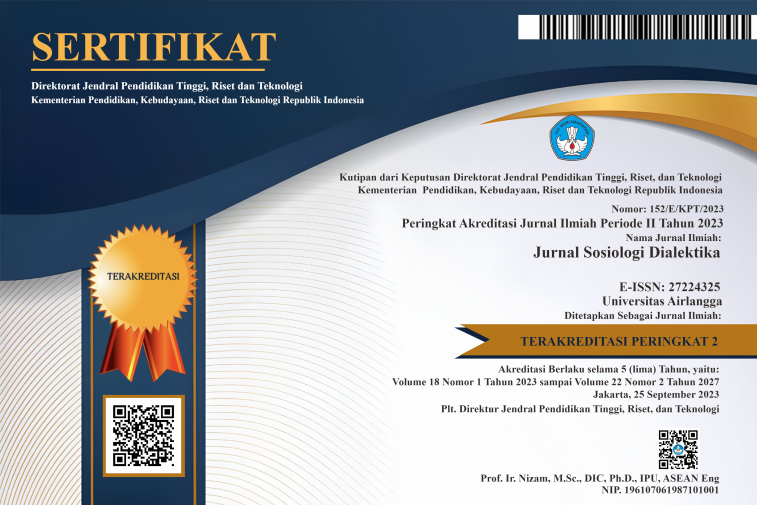Limited access to education for child labors: A study of Bangladesh's Khulna City
Downloads
Child labor is a prevalent issue in Bangladesh, depriving many children of educational opportunities. This study examines the impact of child labor on education. Apart from that, this study also explores various factors such as socio-cultural, economic, environmental, and psychological impacts. This study uses qualitative research methods cross sectional and the study was conducted using primary data. Interviews are conducted with focusing on ten teenagers, including nine boys and one girl. This study clarifies the points influencing the accessibility to education, which are the impacts of child labor. The findings shed light on the challenges in accessing education caused by child labor and can inform social development projects, NGOs, and government initiatives. This study concludes that the importance of emphasizing of collaboration among stakeholders to ensure universal access to quality education. It also suggests that the findings can guide future research and policy development to address child labor and improve educational accessibility.
Ali M (2021) The forbidden terrain of the worst forms of child labour: A critical look at the implications of legal tools and definitions used by national surveys in Bangladesh. Compendium Paper. UNICEF Innocenti, Florence, Italy. https://www.unicef-irc.org/files/documents/d-4169-Child_Labour_Compendium_UNICEF_Innocenti-Ali_Masud.pdf
Alam S, Mondal NI, & Rahman M (2008) Child labor due to poverty: A study on Dinajpur district, Bangladesh. The Social Sciences 3 (5):388-391.
BBS (2015) Child labour and labour force survey 2013 (Survey Report). Bangladesh Bureau of Statistics (BBS), Government of Bangladesh.
Cullen H (2019) The evolving concept of the worst forms of child labor. In: Clark JB & Poucki S (ed). The SAGE Handbook of Human Trafficking and Modern Day Slavery. 139. London: Sage.
Dhaka Tribune (2021) 2 more sectors to be declared child labour-free. Dhaka Tribune, 20 March.[Accessed 14 April 2023]. https://archive.dhakatribune.com/bangladesh/law-rights/2021/03/20/2-moresectors-to-be-declared-child-labour-free.
Dhar PR (2018) Knowledge sharing workshop on good and promising practices and lessons learned to promote decent work for domestic workers and to eliminate child labour in domestic work. Workshop. In: Indonesia and Timor-Leste 23-25 January. Malang: Indonesia.
Delap E (2001) Economic and cultural forces in the child labour debate: Evidence from urban Bangladesh. Journal of Development Studies 37 (4):1-22. https://doi.org/10.1080/00220380412331322021.
Ensing A (2009) Hazardous child labour in the leather sector of Dhaka, Bangladesh. Foundation for International Research on Working Children (IREWOC). https://archive.crin.org/en/docs/Ensing_Leather_Bangladesh_2009.pdf.
Fontana LB & Grugel J (2015) To eradicate or to legalize? Child labor debates and ILO convention 182 in Bolivia. Global Governance: A Review of Multilateralism and International Organizations 21 (1):61-78. https://doi.org/10.1163/19426720-02101006.
Ford N (2019) A future without hazardous child labor in Bangladesh. Global Fund for Children, 13 May. [Accessed 14 April 2023]. https://globalfundforchildren.org/story/a-future-without-hazar dous-child-labor-in-bangladesh/.
Fyfe A (2009) Worst forms of child labor: Agriculture. In: The World of Child Labor. London: Routledge.
Geria G, Omeke M, & Wamala J (2010) A report on the relationship between disabilities and child labour among children and families in Districts of Rakau Mbale and Wakiso. International Labour Office: Jakarta.
Gob (2022) The constitution of the people's Republic of Bangladesh. Government of Bangladesh. http://bdlaws.minlaw.gov.bd/act-367.html?lang=en.
Greenfield MH (2022) An urgent need to reassess climate change and child labour in agriculture. The Lancet Planetary Health 6 (6):e456-e457. https://doi.org/10.1016/S2542-5196(22)00118-8.
Hoque MM (2020) COVID-19 and child labour in Dhaka: Call for reviewed policy actions. IDS Alumni: Blog. [Accessed 14 April 2023]. https://alumni.ids.ac.uk/news/blogs-perspectives-provocationsinitiatives/perspectives-provocations-initiatives-covid-19/542/542Covid-19-and-Child-Labourin-Dhaka-Call-for-reviewed-policy-actions.
Islam E, Mahmud K, & Rahman N (2013) Situation of child domestic workers in Bangladesh. Global Journal of Management and Business Research Finance 13 (7):25-34.
Islam MR (2018) Abuse among child domestic workers in Bangladesh. In: Tshabangu I (ed). Global Ideologies Surrounding Children's Rights and Social Justice. Leeds, West Yorkshire: IGI Global. 1-21. https://doi.org/10.4018/978-1-5225-2578-3.
Jahan N (2022) Over half of Bangladeshi children under 5 don't have birth registration. The Daily Star, 6 January. [Accessed 14 April 2023]. https://www.thedailystar.net/news/bangladesh/rights/news/over-half-bangladeshi-children-under-5-dont-have-birth-registration-2933701.
Jensen KB (2017) Female child domestic workers' limited agency: Working and living in the private homes of employers in Bangladesh. In: Freeman C, Tranter P, & Skelton T (ed). Risk, Protection, Provision and Policy. Singapore: Springer. 87-102. https://doi.org/10.1007/978-981-287-035-3_2.
Kamau P (2010) Upgrading and Technical Efficiency in Kenya Gament Firms: Does Insertion in Global Value Chains Matter? Beasu Bassin: Lambert Academic Publishing.
Karikari I (2016) Child labor: A critical discourse analysis. Dissertation, Indiana University, Bloomington.
Le HT & Homel R (2015) The impact of child labor on children's educational performance: Evidence from rural Vietnam. Journal of Asian Economics 36: 1-13. https://doi.org/10.1016/j.asieco.2014.11.001.
Masum M (2002) Eradication of hazardous child labour in Bangladesh: The need for an integrated strategy. International Journal of Children's Rights 10 (3):233-268. https://doi.org/10.1163/1571 81802761586707.
Maya Jariego I (2021) Dilemmas in public policy against child labor. In: Maya Jariego I (ed). Community Prevention of Child Labor: Evidence-based Practices to Promote the Psychological Well-being of Minors. New York: Springer International Publishing. 89-103. https://doi.org/10.1007/978-3-030-70810-8_7.
Mustafa Z (2019) Poverty in the center of the conversation about child labor in Bangladesh. Law School Student Scholarship 996. https://scholarship.shu.edu/student_scholarship/996.
Pain H (2012) A literature review to evaluate the choice and use of visual methods. International Journal of Qualitative Methods 11 (4):303-319. https://doi.org/10.1177/160940691201100401.
Pandit H (2022) Child labour increasing due to COVID-19. Prothomalo, 31 March. [Accessed 14 April 2023]. https://en.prothomalo.com/opinion/child-labour-increasing-due-to-covid-19.
Pelto B (1995) Questions and answers concerning under-aged garment workers and the prospect of schooling program for them. Dhaka: UNICEF.
Posso A (2019) The health consequences of hazardous and nonhazardous child labor. Review of Development Economics 23 (2):619-639. https://doi.org/10.1111/rode.12571.
Reja S (2017) Elimination of child labor in the garment industry Bangladesh: Failure or a contingent success? Thesis, University of Oslo, Oslo.
Takyi E (2014) Child labour in Ghana: Ecological perspective. Developing Country Studies 4 (10):35-44. https://core.ac.uk/download/pdf/234681679.pdf.

This work is licensed under a Creative Commons Attribution-NonCommercial-ShareAlike 4.0 International License.
1. Copyright of this journal is possession of Editorial Board and Journal Manager, by the knowledge of author, whilst the moral right of the publication belongs to the author.
2. Legal formal aspect of journal publication accessibility refers to Creative Commons Attribution-NonCommercial-ShareAlike (CC BY-NC-SA), implies that publication can be used for non-commercial purposes in its original form (cannot be modified).
3. Every publications (printed/electronic) are open access for educational purposes, research, and library. Other that the aims mentioned above, editorial board is not responsible for copyright violation.















